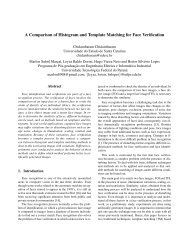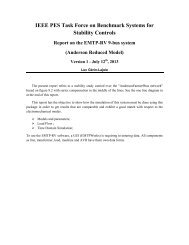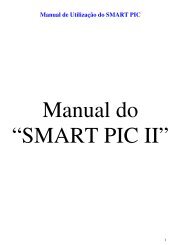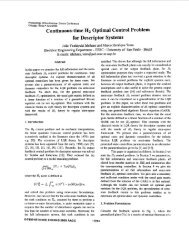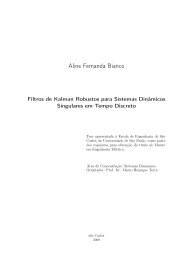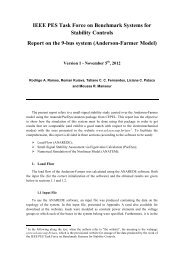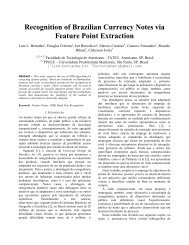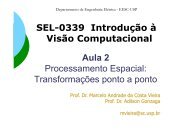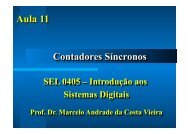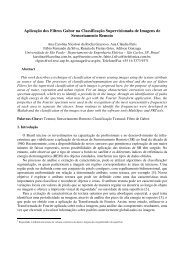<strong>WVC</strong>'<strong>2007</strong> - <strong>III</strong> Workshop de Visão Computacional, 22 a 24 de Outu<strong>br</strong>o de <strong>2007</strong>, São José do Rio Preto, SP.[2] U.N. Schramm, M. Schipper, T. Schurrat, M. Behe, H.Alfke, U. Engeland, G. Ebel and T.M. Behr, “Performance of amulti-pinhole animal SPECT”, Nuclear Science SymposiumConference Record, 2003 IEEE, 19-25 Oct. 2003, v. 3, pp.2077-2079, 2003.[3] G.K. Skinner, “Imaging with coded-aperture masks”, Nuc.Inst. Meth. Phys. Res., v. 221, pp. 33-40, 1984.[4] E. Caroli, J.B. Stephen, G. di Cocco, L. Natalucci and A.Spizzichino, “Coded-aperture imaging in x- and gamma-rayastronomy”, Spa. Sc. Rev., v. 45, pp. 349-403, 1987.[5] E.E. Fenimore and T.M. Cannon, “Coded aperture imagingwith uniformly redundant arrays”, App. Opt., v. 17(3), pp. 337-347, 1978.[6] E.E. Fenimore and T.M. Cannon, “Uniformly redundantarrays: digital reconstruction methods”, App. Opt., v. 20(10), pp.1858-1864, 1981.[7] R.H. Dicke, “Scatter-hole cameras for x-rays and gammarays”,ApJ, v. 153, pp. L101-L106, 1968.[8] J.G. Ables, “Fourier transform photograph: a new methodfor x-ray astronomy”, Proc. ASA, v. 1, pp. 172-173, 1968.[9] T.M. Cannon and E.E. Fenimore, “Tomographical imagingusing uniformly redundant arrays”, App. Opt., v. 18, pp. 1052-1057, 1979.[10] E.E. Fenimore, T.M. Cannon, D.B. Van Hulsteyn and P.Lee, “Uniformly redundant array imaging of laser drivencompressions: preliminary results”, App. Opt., v. 18, pp. 945-947, 1979.[11] Y.W. Chen, M. Yamanaka, N. Miyanaga, T. Yamanaka, S.Nakai, C. Yamanaka and S. Tamura, “Three-dimensionalreconstructions of laser-irradiated targets using URA codedaperture cameras”, Opt. Comm., v. 71(5), pp. 249-255, 1989.[12] W.L. Rogers, K.F. Koral, R. Mayans, P.F. Leonard et al.,“Coded-aperture imaging of the heart”, J. Nucl. Med., v. 21, pp.371-378, 1980.[13] R. Accorsi, F. Gasparini and R.C. Lanza, “A codedaperture for high-resolution nuclear medicine planar imagingwith a conventional Anger camera: experimental results”, IEEEtrans. Nuc. Sci., v. 48, pp. 2411-2417, 2001.[14] R. Accorsi, F. Gasparini and R.C. Lanza, “Optimal codedaperture patterns for improved SNR in nuclear medicineimaging”, Nuc. Inst. Meth Phys. Res. A, v. 474, pp. 273-284,2001.[15] S.R. Gottesman and E.E. Fenimore, “New family of binaryarrays for coded aperture imaging”, App. Opt., v. 28(20), pp.4344-4352, 1989.[16] R. Accorsi and R.C. Lanza, “Near-field artifact reduction inplanar coded aperture imaging”, App. Opt., v. 40(26), pp. 4697-4705, 2001.[17] U.B. Jayanthi and J. Braga, “Physical implementationof an antimask in URA based coded mask systems”, Nucl.Instum. Meth. Phys. Res., v. A310, pp. 685-689, 1991.[18] R. Accorsi and R.C. Lanza, “High-sensitivity dynamiccoded aperture imaging”, Nuc. Sci. Symp. Conf. Record, IEEE,v. 3, pp. 1833-1837, 2003.[19] W.H. Richardson, “Bayesian-based iterative method ofimage restoration”, J. Opt. Soc. Amer., v. 62, pp. 55-59, 1972.[20] L.B. Lucy, “An iterative technique for the rectification ofobserved distribution”, Astron. J., v. 79, pp. 745-754, 1974.[21] J. Braga, Hard X-ray imaging techniques using codedmasks, PhD Thesis, Instituto Astronômico e Geofísico, SãoPaulo, Brazil, 1990.63
<strong>WVC</strong>'<strong>2007</strong> - <strong>III</strong> Workshop de Visão Computacional, 22 a 24 de Outu<strong>br</strong>o de <strong>2007</strong>, São José do Rio Preto, SP.Auto-Fusão da Auto-Face, do Auto-Esboço e da Auto-Pele pelo Misturograma emimagens em nível de cinzaSeverino Jr, OsvaldoIMES - FAFICAosvaldo@fafica.<strong>br</strong>Gonzaga, AdilsonE<strong>sc</strong>ola de Engenharia de São Carlos - <strong>USP</strong>agonzaga@<strong>sc</strong>.<strong>usp</strong>.<strong>br</strong>ResumoNeste trabalho é apresentado um novo método para asegmentação da região de pele e esboço da face emimagens em nível de cinza, através de uma extensão dométodo de quantização de cores definido no sistema RGBe denominado Misturograma. A extensão proposta para oMisturograma permitirá a quantização de cada um dospixels de uma imagem em nível de cinza nas cores preto,azul, verde, ciano, vermelho, magenta, amarelo e <strong>br</strong>anco.A relevância das imagens do esboço da face e da regiãode pele em nível de cinza foi verificada pela auto-fusão. AAuto-fusão é um método de Fusão Multimodal Paraleloefetuado no módulo de decisão.1. IntroduçãoA pele humana é constituída por diferentes misturas decores (pigmentos). A pigmentação define um caráter racialde grande importância e consiste na cor que apresenta apele, o cabelo e a íris do olho. Segundo Domenech [1]levando-se em conta, como caráter fundamental, a cor dapele, pode-se definir grandes grupos ou troncos raciais.Baseando-se no conceito que a pigmentação da pele édefinida por diferentes misturas de cores, o primeiro passodessa pesquisa consistiu na proposta do termoMisturograma [2]. O Misturograma representa um métodode quantização de cores definido pela observação queuma cor é representada pela adição do vermelho, verde eazul no espaço RGB. Na Tabela 1 verifica-se que estaadição pode resultar em oito combinações, onde 0 indica aausência e 1 a presença da cor nos canais R, G e B.Para obterem as oito cores (preto, azul, verde, ciano,vermelho, magenta, amarelo, <strong>br</strong>anco), o Misturogramautiliza a definição binária da cor e realiza um fatiamentode bits, do mais significativo para o menos significativo.Dessa forma, cada fatia será constituída por uma das oitocombinações (Tabela 1). Além disso, cada fatia possui umpeso em relação à mistura final da cor que decre<strong>sc</strong>e do bitmais significativo para o menos significativo.Tabela 1. Combinações de Cores no RGB.CanaisCorR G B Resultante0 0 0 Preto0 0 1 Azul0 1 0 Verde0 1 1 Ciano1 0 0 Vermelho1 0 1 Magenta1 1 0 Amarelo1 1 1 BrancoPortanto, a mistura final pode ser expressa por umvalor v, tal que:v =K∑= i 02i2 1( R 2 + G 2 + B )i28i−1Na Tabela 2 observa-se que para C, no espaço RGB, iguala (109,146,137) a representação binária é (01101101,10010010, 10001001) e o valor v será igual a 3 , 3923.Tabela 2. Representação de v pelo fatiamento de bits, domais para o menos significativo de uma cor no RGB.bits R G B Cor7 0 1 1 Ciano6 1 0 0 Vermelho5 1 0 0 Vermelho4 0 1 0 Verde3 1 0 1 Magenta2 1 0 0 Vermelho1 0 1 0 Vermelho0 1 0 1 MagentaDessa forma, qualquer mistura de cores poderá serquantizada a um valor v entre 0 e 7, onde 0 correspondeao valor RGB igual a (0,0,0) e 7 ao valor RGB igual a(255,255,255). Entretanto, para determinar uma cor apartir de v, definiu-se um intervalo i igual a 0,875 (7/8)para expressar a seqüência de cores (preto, azul, verde,i(1)64
- Page 1 and 2:
III Workshop de VisãoComputacional
- Page 3 and 4:
Instituto de Biociências, Letras e
- Page 5 and 6:
WVC 2007 - III Workshop de Visão C
- Page 7 and 8:
ApresentaçãoA área de Visão Com
- Page 10 and 11:
Automatic Pattern Recognition of Bi
- Page 12 and 13:
WVC'2007 - III Workshop de Visão C
- Page 14 and 15:
WVC'2007 - III Workshop de Visão C
- Page 16:
WVC'2007 - III Workshop de Visão C
- Page 19:
WVC'2007 - III Workshop de Visão C
- Page 22 and 23:
WVC'2007 - III Workshop de Visão C
- Page 24 and 25: WVC'2007 - III Workshop de Visão C
- Page 26 and 27: WVC'2007 - III Workshop de Visão C
- Page 28 and 29: WVC'2007 - III Workshop de Visão C
- Page 30 and 31: WVC'2007 - III Workshop de Visão C
- Page 33 and 34: WVC'2007 - III Workshop de Visão C
- Page 35 and 36: WVC'2007 - III Workshop de Visão C
- Page 37 and 38: WVC'2007 - III Workshop de Visão C
- Page 39 and 40: WVC'2007 - III Workshop de Visão C
- Page 41 and 42: WVC'2007 - III Workshop de Visão C
- Page 43 and 44: WVC'2007 - III Workshop de Visão C
- Page 45 and 46: WVC'2007 - III Workshop de Visão C
- Page 47 and 48: WVC'2007 - III Workshop de Visão C
- Page 49 and 50: WVC'2007 - III Workshop de Visão C
- Page 51 and 52: WVC'2007 - III Workshop de Visão C
- Page 53 and 54: WVC'2007 - III Workshop de Visão C
- Page 55 and 56: WVC'2007 - III Workshop de Visão C
- Page 57 and 58: WVC'2007 - III Workshop de Visão C
- Page 59 and 60: WVC'2007 - III Workshop de Visão C
- Page 61 and 62: WVC'2007 - III Workshop de Visão C
- Page 63 and 64: WVC'2007 - III Workshop de Visão C
- Page 65 and 66: WVC'2007 - III Workshop de Visão C
- Page 67 and 68: WVC'2007 - III Workshop de Visão C
- Page 69 and 70: WVC'2007 - III Workshop de Visão C
- Page 71 and 72: WVC'2007 - III Workshop de Visão C
- Page 73: WVC'2007 - III Workshop de Visão C
- Page 77 and 78: WVC'2007 - III Workshop de Visão C
- Page 79 and 80: WVC'2007 - III Workshop de Visão C
- Page 81 and 82: WVC'2007 - III Workshop de Visão C
- Page 83 and 84: WVC'2007 - III Workshop de Visão C
- Page 85 and 86: WVC'2007 - III Workshop de Visão C
- Page 87 and 88: WVC'2007 - III Workshop de Visão C
- Page 89 and 90: WVC'2007 - III Workshop de Visão C
- Page 91 and 92: WVC'2007 - III Workshop de Visão C
- Page 93 and 94: WVC'2007 - III Workshop de Visão C
- Page 95 and 96: WVC'2007 - III Workshop de Visão C
- Page 97 and 98: WVC'2007 - III Workshop de Visão C
- Page 99 and 100: WVC'2007 - III Workshop de Visão C
- Page 101 and 102: WVC'2007 - III Workshop de Visão C
- Page 103 and 104: WVC'2007 - III Workshop de Visão C
- Page 105 and 106: WVC'2007 - III Workshop de Visão C
- Page 107 and 108: WVC'2007 - III Workshop de Visão C
- Page 109 and 110: WVC'2007 - III Workshop de Visão C
- Page 111 and 112: WVC'2007 - III Workshop de Visão C
- Page 113 and 114: WVC'2007 - III Workshop de Visão C
- Page 115 and 116: WVC'2007 - III Workshop de Visão C
- Page 117 and 118: WVC'2007 - III Workshop de Visão C
- Page 119 and 120: WVC'2007 - III Workshop de Visão C
- Page 121 and 122: WVC'2007 - III Workshop de Visão C
- Page 123 and 124: WVC'2007 - III Workshop de Visão C
- Page 125 and 126:
WVC'2007 - III Workshop de Visão C
- Page 127 and 128:
WVC'2007 - III Workshop de Visão C
- Page 129 and 130:
WVC'2007 - III Workshop de Visão C
- Page 131 and 132:
WVC'2007 - III Workshop de Visão C
- Page 133 and 134:
WVC'2007 - III Workshop de Visão C
- Page 135 and 136:
WVC'2007 - III Workshop de Visão C
- Page 137 and 138:
WVC'2007 - III Workshop de Visão C
- Page 139 and 140:
WVC'2007 - III Workshop de Visão C
- Page 141 and 142:
WVC'2007 - III Workshop de Visão C
- Page 143 and 144:
WVC'2007 - III Workshop de Visão C
- Page 145 and 146:
WVC'2007 - III Workshop de Visão C
- Page 147 and 148:
WVC'2007 - III Workshop de Visão C
- Page 149 and 150:
WVC'2007 - III Workshop de Visão C
- Page 151 and 152:
WVC'2007 - III Workshop de Visão C
- Page 153 and 154:
WVC'2007 - III Workshop de Visão C
- Page 155 and 156:
WVC'2007 - III Workshop de Visão C
- Page 157 and 158:
WVC'2007 - III Workshop de Visão C
- Page 159 and 160:
WVC'2007 - III Workshop de Visão C
- Page 161 and 162:
WVC'2007 - III Workshop de Visão C
- Page 163 and 164:
WVC'2007 - III Workshop de Visão C
- Page 165 and 166:
WVC'2007 - III Workshop de Visão C
- Page 167 and 168:
WVC'2007 - III Workshop de Visão C
- Page 169 and 170:
WVC'2007 - III Workshop de Visão C
- Page 171 and 172:
WVC'2007 - III Workshop de Visão C
- Page 173 and 174:
WVC'2007 - III Workshop de Visão C
- Page 175 and 176:
WVC'2007 - III Workshop de Visão C
- Page 177 and 178:
WVC'2007 - III Workshop de Visão C
- Page 179 and 180:
WVC'2007 - III Workshop de Visão C
- Page 181 and 182:
WVC'2007 - III Workshop de Visão C
- Page 183 and 184:
WVC'2007 - III Workshop de Visão C
- Page 185 and 186:
WVC'2007 - III Workshop de Visão C
- Page 187 and 188:
WVC'2007 - III Workshop de Visão C
- Page 189 and 190:
WVC'2007 - III Workshop de Visão C
- Page 191 and 192:
WVC'2007 - III Workshop de Visão C
- Page 193 and 194:
WVC'2007 - III Workshop de Visão C
- Page 195 and 196:
WVC'2007 - III Workshop de Visão C
- Page 197 and 198:
WVC'2007 - III Workshop de Visão C
- Page 199 and 200:
WVC'2007 - III Workshop de Visão C
- Page 201 and 202:
WVC'2007 - III Workshop de Visão C
- Page 203 and 204:
WVC'2007 - III Workshop de Visão C
- Page 205 and 206:
WVC'2007 - III Workshop de Visão C
- Page 207 and 208:
WVC'2007 - III Workshop de Visão C
- Page 209 and 210:
WVC'2007 - III Workshop de Visão C
- Page 211 and 212:
WVC'2007 - III Workshop de Visão C
- Page 213 and 214:
WVC'2007 - III Workshop de Visão C
- Page 215 and 216:
WVC'2007 - III Workshop de Visão C
- Page 217 and 218:
WVC'2007 - III Workshop de Visão C
- Page 219 and 220:
WVC'2007 - III Workshop de Visão C
- Page 221 and 222:
WVC'2007 - III Workshop de Visão C
- Page 223 and 224:
WVC'2007 - III Workshop de Visão C
- Page 225 and 226:
WVC'2007 - III Workshop de Visão C
- Page 227 and 228:
WVC'2007 - III Workshop de Visão C
- Page 229 and 230:
WVC'2007 - III Workshop de Visão C
- Page 231 and 232:
WVC'2007 - III Workshop de Visão C
- Page 233 and 234:
WVC'2007 - III Workshop de Visão C
- Page 235 and 236:
WVC'2007 - III Workshop de Visão C
- Page 237 and 238:
WVC'2007 - III Workshop de Visão C
- Page 239 and 240:
WVC'2007 - III Workshop de Visão C
- Page 241 and 242:
WVC'2007 - III Workshop de Visão C
- Page 243 and 244:
WVC'2007 - III Workshop de Visão C
- Page 245 and 246:
WVC'2007 - III Workshop de Visão C
- Page 247 and 248:
WVC'2007 - III Workshop de Visão C
- Page 249 and 250:
WVC'2007 - III Workshop de Visão C
- Page 251 and 252:
WVC'2007 - III Workshop de Visão C
- Page 253 and 254:
WVC'2007 - III Workshop de Visão C
- Page 255 and 256:
WVC'2007 - III Workshop de Visão C
- Page 257 and 258:
WVC'2007 - III Workshop de Visão C
- Page 259 and 260:
WVC'2007 - III Workshop de Visão C
- Page 261 and 262:
WVC'2007 - III Workshop de Visão C
- Page 263 and 264:
WVC'2007 - III Workshop de Visão C
- Page 265 and 266:
WVC'2007 - III Workshop de Visão C
- Page 267 and 268:
WVC'2007 - III Workshop de Visão C
- Page 269 and 270:
WVC'2007 - III Workshop de Visão C
- Page 271 and 272:
WVC'2007 - III Workshop de Visão C
- Page 273 and 274:
WVC'2007 - III Workshop de Visão C
- Page 275 and 276:
WVC'2007 - III Workshop de Visão C
- Page 277 and 278:
WVC'2007 - III Workshop de Visão C
- Page 279 and 280:
WVC'2007 - III Workshop de Visão C
- Page 281 and 282:
WVC'2007 - III Workshop de Visão C
- Page 283 and 284:
WVC'2007 - III Workshop de Visão C
- Page 285 and 286:
WVC'2007 - III Workshop de Visão C
- Page 287 and 288:
WVC'2007 - III Workshop de Visão C
- Page 289 and 290:
WVC'2007 - III Workshop de Visão C
- Page 291 and 292:
WVC'2007 - III Workshop de Visão C
- Page 293 and 294:
WVC'2007 - III Workshop de Visão C
- Page 295 and 296:
WVC'2007 - III Workshop de Visão C
- Page 297 and 298:
WVC'2007 - III Workshop de Visão C
- Page 299 and 300:
WVC'2007 - III Workshop de Visão C
- Page 301 and 302:
WVC'2007 - III Workshop de Visão C
- Page 303 and 304:
WVC'2007 - III Workshop de Visão C
- Page 305 and 306:
WVC'2007 - III Workshop de Visão C
- Page 307 and 308:
WVC'2007 - III Workshop de Visão C
- Page 309 and 310:
WVC'2007 - III Workshop de Visão C
- Page 311 and 312:
WVC'2007 - III Workshop de Visão C
- Page 313 and 314:
WVC'2007 - III Workshop de Visão C
- Page 315 and 316:
WVC'2007 - III Workshop de Visão C
- Page 317 and 318:
WVC'2007 - III Workshop de Visão C
- Page 319 and 320:
WVC'2007 - III Workshop de Visão C
- Page 321 and 322:
WVC'2007 - III Workshop de Visão C
- Page 323 and 324:
WVC'2007 - III Workshop de Visão C
- Page 325 and 326:
WVC'2007 - III Workshop de Visão C
- Page 327 and 328:
WVC'2007 - III Workshop de Visão C
- Page 329 and 330:
WVC'2007 - III Workshop de Visão C
- Page 331 and 332:
WVC'2007 - III Workshop de Visão C
- Page 333 and 334:
WVC'2007 - III Workshop de Visão C
- Page 335 and 336:
WVC'2007 - III Workshop de Visão C
- Page 337 and 338:
WVC'2007 - III Workshop de Visão C
- Page 339 and 340:
WVC'2007 - III Workshop de Visão C
- Page 341 and 342:
WVC'2007 - III Workshop de Visão C
- Page 343 and 344:
WVC'2007 - III Workshop de Visão C
- Page 345 and 346:
WVC'2007 - III Workshop de Visão C
- Page 347 and 348:
WVC'2007 - III Workshop de Visão C
- Page 349 and 350:
WVC'2007 - III Workshop de Visão C
- Page 351 and 352:
WVC'2007 - III Workshop de Visão C
- Page 353 and 354:
WVC'2007 - III Workshop de Visão C
- Page 355 and 356:
WVC'2007 - III Workshop de Visão C
- Page 357 and 358:
WVC'2007 - III Workshop de Visão C
- Page 359 and 360:
WVC'2007 - III Workshop de Visão C
- Page 361 and 362:
WVC'2007 - III Workshop de Visão C
- Page 363:
WVC'2007 - III Workshop de Visão C




